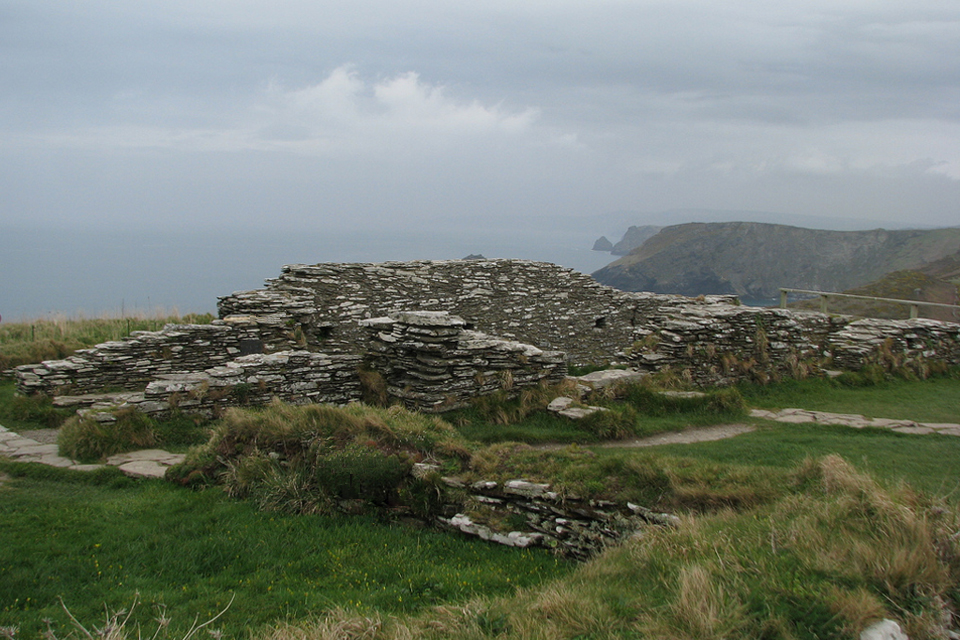In 1225 Richard, 1st Earl of Cornwall swapped smiling land at Merthen in the south of Cornwall for windy Tintagel in the north in order to rebuild the old royal seat of his newly acquired “land”. New theory is that the site was chosen more for its links to the legend of Tristan and Yseult, than its fame as the site for King Arthur’s conception.
When Tintagel Castle was built, it was set in a location with no obvious defensive or strategic significance. Further, Richard acquired it in a land-swap, which does not seem to have been particularly advantageous. Why, one may well ask?
The standard answer is, that Richard aimed to rebuild the ancient royal seat of the legendary rulers of Cornwall, the Dumnonians. It is also generally believed that he was inspired by the history of Geoffrey of Monmouth, who famously claimed that Arthur had been conceived here (it was not until the 15th century his birth was also located at the site).
In a recent article published in the new journal, Historic England Research Marc Bowden summaries the evidence for a slightly different understanding. Perhaps it was rather the story about Tristan and Yseult, which inspired the King’s brother to his building enterprise? One reason is that the story of the two lovers, as we know it, mentions three important locations: a garden or orchard, a chapel on a cliff and an “underground” grotto, cave or cellar. Exactly such features may be found at the rocky promontory or peninsula, which lies to the north of the inner ward of the castle of Tintagel. With their odd location – chapels would for instance usually be located next to the main hall – they have often puzzled historians and archaeologists.
However, recognising the descriptions in the preserved fragments of the poem about the two lovers, it soon becomes obvious that Richard was perhaps not so much bent on rebuilding the castle of Arthur; rather, he was aiming to recreate a romantic setting, where he might physically envision and experience the legend. Especially the location of the chapel is significant. The chapel was situated above exactly such a cliff, which plays an important role in the poem, when Tristan seeks to evade being burned by begging to be allowed to pray alone on his way to the scaffold. In the chapel there is only one door, and he will not be able to escape. Which he does, of course, through the window performing what was later know as “Tristan’s Leap”.
“My lords, let me enter this chantry, to pray for a moment the mercy of God whom I have offended; my death is near. There is but one door to the place, my lords, and each of you has his sword drawn. So, you may well see that, when my prayer to God is done, I must come past you again: when I have prayed God, my lords, for the last time. And one of the guards said: “Why, let him go in.” So they let him enter to pray. But he, once in, dashed through and leapt the altar rail and the altar too and forced a window of the apse, and leapt again over the cliff’s edge. So might he die, but not of that shameful death before the people. Now learn, my lords, how generous was God to him that day. The wind took Tristan’s cloak and he fell upon a smooth rock at the cliff’s foot, which to this day the men of Cornwall call “Tristan’s leap.”
(From: The Romance of Tristan and Iseult. Unknown; Compiled into French by Joseph Bédier; Translated by Hilaire Belloc)
Marc Bowden is careful to note that Richard was perhaps not alone in the responsibility for the romantic recreation of the landscape of this Cornish legend. Co-creators may easily have been any of his three wives – Isabella Marshall, Sanchia of Provence or Beatrice of Falkenberg. All of these ladies would presumably have been well acquainted with the original 12th century poem by Thomas of Britain or any of its later rewritings.
How was this symbolic landscape used in the 13th century? As a piece of cultural heritage, which could be shown to visitors on the Cornish tourist trail? Or did the Earl and his entourage playact the romance “on location”? We don’t know.
But it is obviously fun to walk around and imagine people in the Middle Ages posing as modern day medieval re-enactors! The new interpretation at Tintagel helps this on its way by telling the story at the remains of the walled garden from the 13th century.
SOURCE:
Tintagel and the Legend of Tristan and Yseult.
By Mark Bowden
in: Historic England research 2015, issue 2
